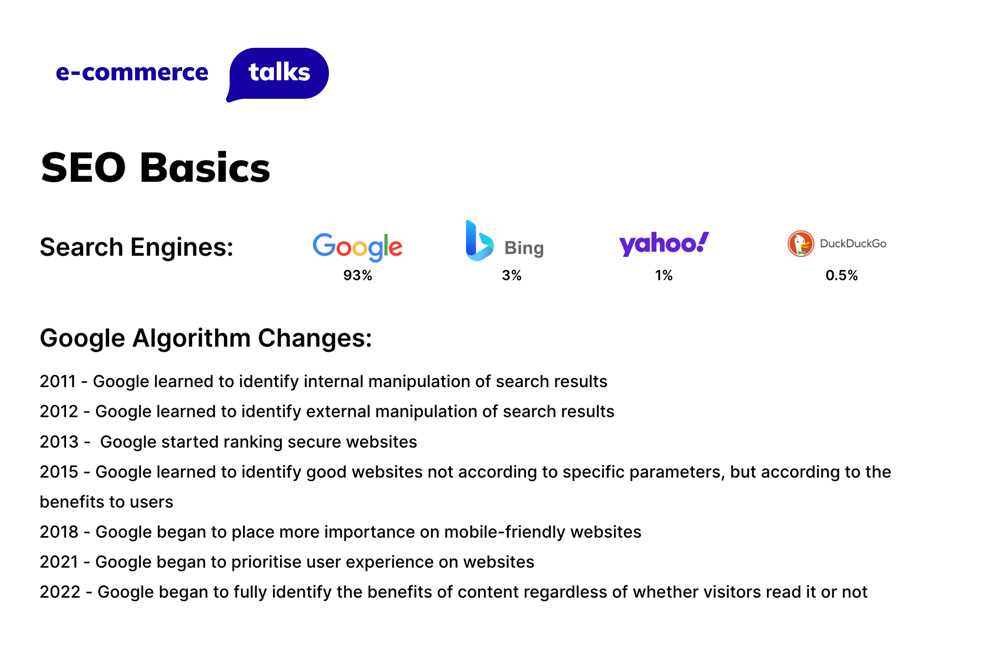Underrated and overrated SEO strategies for attracting buyers to an e-shop

SEO basics
Before diving into specific tips, it's crucial to understand that SEO is a long-term strategy, unlike paid advertising, where results can be seen almost immediately. With SEO, patience is key, as the benefits often take time to materialise. It's common not to see significant results for several months, so maintaining a long-term perspective is essential.
What is SEO?
SEO, or Search Engine Optimisation, is a strategic process aimed at enhancing your website's visibility on search engines like Google. By improving your site's ranking on search result pages, SEO helps attract more user traffic and potential buyers.
How does SEO work?
Search engines evaluate your website and brand, comparing them against other relevant sources. They then rank these sites based on the value they provide to search users. SEO is not a quick fix – it's a gradual process focused on delivering value to your audience. Immediate results are rare; instead, think of SEO as a long-term investment in your website's user experience and content quality.
Search Engines
When it comes to search engines, Google stands out with a staggering 93% market share. This naturally begs the question: is it worth investing time and resources in other search engines?
Focusing on Google is not just beneficial due to its overwhelming market dominance, it’s also because other search engines are striving to catch up with Google’s advanced algorithms. Many of the rules and factors that affect search rankings on other platforms are modelled after Google’s practices.
A decade ago, manipulating Google’s algorithms to boost a website’s ranking through technical tricks was relatively straightforward. However, by 2011, Google had significantly advanced its ability to detect and counteract such manipulations. As illustrated in the visual below, Google’s algorithm has been consistently improving over the years.

Which SEO actions are overrated and which are useful?
Let's start with what you shouldn't do in order to achieve the best SEO results for your e-shop.
AVOID doing SEO when your e-shop is not ready
Here are a few signs that indicate your e-shop is not yet ready for SEO actions:
- Limited product range If you sell only one or a few products while your competitors offer dozens or even hundreds, your e-shop may not be competitive enough for effective SEO.
- Lack of categories Having few or no product categories can be a drawback, especially if your competitors have well-organised and numerous categories.
- Your products stand out. If you offer different products, targeting broad keywords might not be effective. For example, if you sell eco-friendly water bottles but aim to rank for the keyword "water bottles," you need to analyse the market. Determine whether users searching for "water bottles" are specifically looking for eco-friendly options or a broader selection. If your competitors don't focus on niche products like yours, it might indicate that your e-shop is not yet ready for SEO actions.
AVOID ignoring the technical aspects
The technical aspects are crucial from the very beginning, and the sooner they are in order, the better it is for the project. In this context, you should carefully choose a system template. Evaluate whether it is fast, capable of implementing all your goals, and whether the content management system includes all the necessary functions. Delaying the establishment of the technical foundation can lead to increased costs later on.
AVOID preferring quantity over quality
It's a misconception to think that SEO is all about cramming your site with as much content and as many keywords as possible. In reality, SEO prioritises value over volume. Excessive content can clutter your site, making it harder for users to find products or other important information, ultimately harming your results.
Google is adept at detecting keyword stuffing, and users can easily spot unnatural text. Instead, focus on creating valuable, user-friendly content that genuinely meets the needs of your audience.

AVOID relying on cheap, external links
External links are hyperlinks from other websites that lead to your site. These links are typically added when other sites reference or discuss your content. While external links are beneficial for SEO, their quality is crucial.
High-quality external links can significantly improve your SEO ranking. The more reputable and relevant the links, the better your SEO results will be. However, relying on low-quality links can lead to two major issues:
- Violation of Google's rules: Google's guidelines prohibit the buying of links. If detected, your SEO rankings may drop.
- Wasted resources: Purchasing cheap, low-quality links can be a waste of money, as Google may simply disregard these links, providing no benefit to your SEO efforts.
Note! Be cautious of emails offering to sell numerous external links at attractive prices. These offers often claim to boost your ranking quickly. Here’s why this is a red flag: 1) Unrealistic promises: Genuine SEO improvement requires more than just acquiring external links. It involves comprehensive on-site optimisation and quality content; 2) Potential harm: Engaging with such services can harm your site's reputation and SEO performance.
AVOID using other outdated SEO strategies prohibited by Google
Keyword Stuffing. Instead, use keywords sparingly and ensure they fit naturally within the context of your content.
Hidden text. For example: using white font on a white background. This strategy is easily detected by Google and adds no value to your content. If you struggle to incorporate keywords seamlessly, it's better to weave them into the text contextually. Google is adept at understanding the overall context and relevance of your content.
Content theft. Stealing content from other websites will eventually harm your site. Google prioritises unique, original content. Ensure all content on your site is unique and adds value to your readers.
Overreliance on AI-Generated Content. Blindly generating content using AI tools like ChatGPT is not advisable. Search engines and users can often distinguish AI-generated content from human-written text. While AI can be a valuable tool for inspiration and generating ideas, it should not replace authentic, user-focused content creation.
Negative SEO strategies. Avoid engaging in negative SEO strategies against competitors, such as creating low-quality, spammy links. This unethical practice can backfire and harm your own site's reputation.

Key principles for successful SEO
Focusing solely on what not to do will only give you part of the picture when it comes to achieving good SEO results for your e-shop. To truly succeed, you need to know the specific practices that work. Let's discuss these effective strategies:
Effective SEO strategy #1: Strong technical foundation
To ensure a strong technical foundation for your e-shop, focus on these key areas:
- Responsive website design. Your website should have an interactive design that adapts seamlessly to phones, tablets, and computers. This ensures a convenient and enjoyable shopping experience for users across all devices.
- SSL certificate. Ensure your website address starts with HTTPS. The "S" signifies that your site has an SSL certificate.
- Indexing and crawling capabilities. This typically requires a skilled programmer or specialist to verify that your pages are properly indexed and visible in Google search results
- Loading speed. Optimise your website for fast loading times. Utilise a fast server, compress images without sacrificing quality, and minimise excess code.
- SEO-friendly URL structure. Ensure your website URLs are clear, concise, and static. Avoid ambiguous symbols and keep URLs consistent to improve search engine readability and user navigation.
- Avoiding duplicate content. Make sure your site does not have duplicate pages with the same content but different addresses. If duplicates are necessary, use canonical tags or other methods to distinguish between them.

Effective SEO strategy #2: Enhanced assortment
Offering a diverse and relevant range of products, along with a broad selection of categories, can significantly boost your e-shop's SEO ranking.
Effective SEO strategy #3: Carefully planned category tree
Avoid categories of equal value. Ensure your category tree has a logical flow and contains appropriate keywords. Avoid trying to rank multiple categories with the same keyword, as this can confuse Google and result in neither category ranking well. Instead, differentiate categories clearly to establish a primary one.
Optimise categories. Strive for balance in category breadth and depth. For broad categories, consider breaking them down into narrower, more specific subcategories. Conversely, if a category is too narrow with few products and low demand, it may be beneficial to merge it into a broader category. For instance, if you have the categories "Mobile phones" and "Mobile phone accessories" but there is insufficient demand for them separately, consider combining them into a single category.
Manage Menu Visibility. Not all categories need to be displayed in the main menu. Given the limited space, it's important to avoid overloading it. You can strategically link to hidden categories from other pages.

Effective SEO strategy #4: Category optimisation
Provide different titles for users and Google searches. Users already browsing your website are familiar with your area and know what kind of product to expect. For these users, brief category names like "Toys" or "Toys for Children" are sufficient. However, people searching on Google and trying to decide which shop to visit need broader titles. Make these titles clearer and more distinct from your competitors.
Use both popular short keywords and long ones. If you have a main keyword, don't forget the secondary ones that would be less competitive. For example, "Toys" and "Toys for Children" – the latter will rank higher initially, while the main keyword will gain traction over time as your site's authority grows.
Implement elements that improve the user experience. Convenient navigation, filters, reviews, and other features that enhance user experience are essential.
Effective SEO strategy #5: Product and image optimisation
Ensure informative, useful and unique product descriptions. A common mistake is copying descriptions from suppliers and other websites. Google highly values original content, and duplicating descriptions found elsewhere can hurt your search engine rankings. If you manage a large assortment and rewriting every description from scratch is impractical, consider adding supplementary text to provide additional value.
You can also optimise products and images by using unique images and their code descriptions (ALT texts), as well as providing suggestions for similar products.

Effective SEO strategy #6: Blog (blog posts)
Creating informational content about topics related to your field can significantly enhance your topical authority. By providing direct answers about your business and seamlessly integrating your products into your articles, you can attract and engage your audience more effectively. Some content management systems, including Shopify, offer built-in blogging features to help you get started.
Effective SEO strategy #7: Schema markup
- Display product specifications in search.
- Display product prices and ratings.
- Display frequently asked questions.
If your competitors haven't adopted this strategy, you have a golden opportunity to differentiate your offerings and provide comprehensive information directly to potential customers.

Effective SEO strategy #8: Improving the user experience
- Provide reviews.
- Add filters and sorting.
- Enable smooth shopping ("Add to cart", "Out of stock", etc.).
- Display relevant discounts to your audience.
- Add and test elements that encourage sales.
Effective SEO strategy #9: Natural external link network
- Choose value-adding portals. External links act as endorsements, showcasing how other sites value your content. They reflect both the quality and quantity of websites that find your content valuable.
- Focus on writing articles that appear organic and provide genuine value to readers.
- Deliberately choose the pages you link to, ensuring they are relevant and beneficial to your audience.

Summing up
If you want your business to be visible in Google search results, your top priority should be user convenience. We believe the tips in this blog post will help you adapt your e-shop to Google's algorithm and achieve successful growth!


